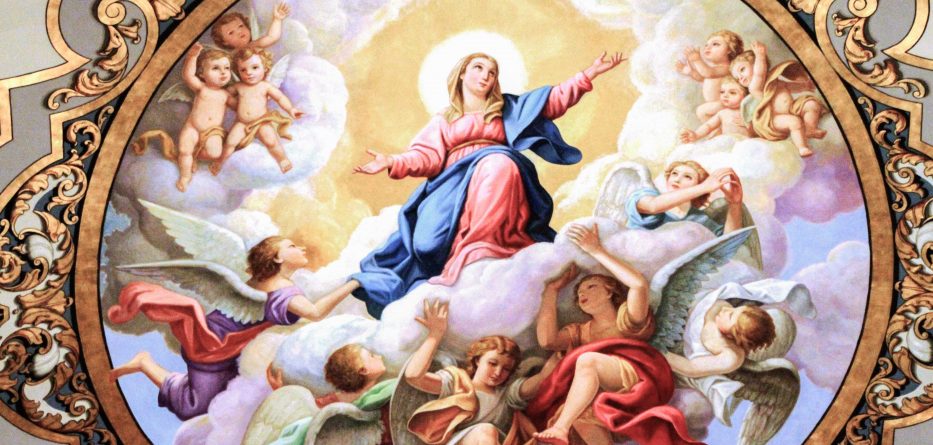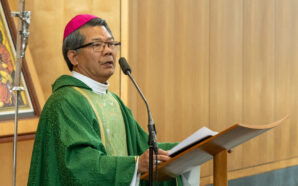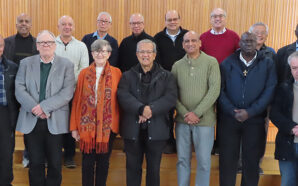Delivered by Seminarian Jack Green to IGNITE Youth at Saint John XXIII Catholic Parish, Stanhope Gardens on 28 May, 2017.
II – Mary preaching
Now, something common to many of the early disciples of Christ was preaching. John the Baptist, for example, drew people from all over Judea through his preaching (Matt. 3:5), and a great part of the early Church’s activity was taken up by preaching. Yet I don’t think too many people think of Mary as a preacher.
We can find no long speeches addressing large crowds, like we can with St. Peter at Pentecost (cf. Acts. 2:14-42); nor can we find any account of Mary going around the countryside proclaiming the Gospel as we can with the apostles after they received the Holy Spirit. Yet she was there; she received the same Spirit. In fact, if you collected all the recorded words of Mary found in the Gospels, you would probably get no more than half an A4 page (at a guess).
Yet for all that, if we look properly, we can see that Mary did preach, and preach very well. To see that, let us turn again to the Gospel of Luke – I think you’re beginning to see that if you want to know about Mary you have to read Luke’s Gospel. There we find the scene of the meeting between Mary and Elizabeth where the older one, Elizabeth, speaks those prophetic words to Mary that we recite whenever we pray the Hail Mary (cf. Luke 1:39-55). Notice how Mary responds, though:
My soul magnifies the Lord,
47 and my spirit rejoices in God my Saviour,
48 for he has looked on the humble estate of his servant.
For behold, from now on all generations will call me blessed;
49 for he who is mighty has done great things for me,
and holy is his name.
50 And his mercy is for those who fear him
from generation to generation.
51 He has shown strength with his arm;
he has scattered the proud in the thoughts of their hearts;
52 he has brought down the mighty from their thrones
and exalted those of humble estate;
53 he has filled the hungry with good things,
and the rich he has sent away empty.
54 He has helped his servant Israel,
in remembrance of his mercy,
55 as he spoke to our fathers,
to Abraham and to his offspring forever
Some of you, I hope, will recognise that as the prayer ‘the Magnificat’ which people like me and Fr. John pray every evening when we pray the Divine Office. But it is not simply a prayer, it is really Mary preaching to Elizabeth. For what, after all, is preaching but the witnessing to others about the saving mystery of God in the world? That is precisely what Mary does here. Notice she calls God ‘my Saviour’ – something that will recur in Christian preaching from then until the present day.
Notice also, how she cites several things God has done in the world: ‘he has done great things for me…he has scattered the proud in the thoughts of their hearts…he has filled the hungry with good things.’ All these things are instances of God’s action in the world and Mary stands before her cousin Elizabeth and boldly proclaims them to her. Sure, it’s not in front of the thousands of people in Jerusalem like Peter’s sermon, or in front of all the philosophers in Athens like St. Paul (cf. Acts. 17:16-34); it is in front of an old woman in a small village in the hill country of Judea – a backwater of the Roman Empire. But it is preaching nonetheless.
Here we can learn something very valuable for ourselves. So often as young people we think big, we make grand plans, and hope that they succeed. That is a good thing; being idealistic is great. And when we start to get into our faith a bit more, we do the same thing: we want to go and convert the whole of China, or stop all abortions, or come back from WYD and make the best youth group there’s ever been.
Again, these are all really good, noble desires.
But sometimes we forget that God often asks us to preach in little, unnoticed ways: a kind word to a stranger, a correction to our friend who is leading us astray, or simply confidently telling someone that we are Catholic and we love it. This is how Mary preached: in small, simple ways, but boldly. And notice something: we are still reading things she said today, two thousand years later. See, it’s often the little things we say, a strong word, a kind word, a judicious word that people remember and it’s this that Mary teaches us.
From her we learn that following Jesus Christ and preaching him to the world involves the willingness to be small, to do small things with a big heart for God. A great book in this regard is St. Therese of Lisiuex’s A Story of a Soul. It is really essential reading for every Catholic, I think.
But before we move onto Mary as a pointer, there is one more thing we can learn from Mary as a preacher. The Magnificat proclaimed to Elizabeth is actually very similar to a prayer Hannah prayed in the Old Testament upon somewhat miraculously conceiving a son. So much so that Mary is almost quoting it in some places. What this tells us is that Mary knew her Scriptures, she knew her faith. She didn’t start preaching without anything in the tank, as it were. She spoke what she first received, learnt, knew. There’s an old saying: you can’t give what you don’t have, and that is entirely true when it comes to preaching.
For us, then, that should be impetus to start getting to know our faith better and better. If we want to start sharing the truth of Christ with others then we must first think: what am I going to tell them, what do they need to hear? And if we can’t answer those questions then we won’t be nearly as effective as we could be, not only in preaching Christ, but in being his disciples too.
Delivered by Seminarian Jack Green to IGNITE Youth at Saint John XXIII Catholic Parish, Stanhope Gardens on 28 May, 2017.
Part 3 and Conclusion will be published next Thursday.
To read Part 1 of Mary: The Model Disciple, click here.








